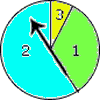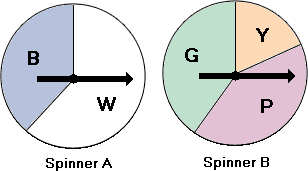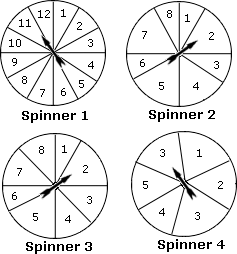Solved Examples and Worksheet for Identifying Equally Likely Outcomes
A. a likely event
B. an unlikely event
C. an equally likely as unlikely event
D. none of these
Step: 1
The event will not happen.
Step: 2
So, it is an unlikely event.
Correct Answer is : an unlikely event
A. a likely event
B. an unlikely event
C. an equally likely event
D. an impossible event
Step: 1
The event is just as likely to happen as not to happen.
Step: 2
So, it is an equally likely event.
Correct Answer is : an equally likely event

A. 2
B. 3
C. 1
D. None of these
Step: 1
The yellow colored sector which is numbered as 3 has the minimum area.
Step: 2
So, the spinner has a chance that most likely to stop on 3.
Correct Answer is : 3

A. 6
B. 1
C. 3
D. 2
Step: 1
A possible outcome is something that has a chance of happening.
Step: 2
The possible outcomes are (B, G), (B, Y), (B, P), (W, G), (W, Y) and (W, P).
Step: 3
So, there are 6 possible outcomes when both the spinners are spinned simultaneously.
Correct Answer is : 6

A. Spinner 1
B. Spinner 4
C. Spinner 3
D. Spinner 2
Step: 1
The spinner 1 is divided into 12 equal parts.
Step: 2
The spinner 2 is divided into 8 unequal parts.
Step: 3
The spinner 3 is divided into 8 unequal parts.
Step: 4
The spinner 4 is divided into 5 unequal parts.
Step: 5
So, spinner 1 has the probability of all the outcomes being equal.
Correct Answer is : Spinner 1
A. 3
B. 1
C. 2
D. 6
Step: 1
In probability, when there are the same chances of more than one event to happen, the events are equally likely to occur.
Step: 2
When we roll a six sided cube, the equally likely outcomes are 1, 2, 3, 4, 5, 6.
Step: 3
So there are 6 equally likely outcomes.
Correct Answer is : 6
A. Choosing a yellow marble from a bag of 2 red marbles and 5 yellow marbles.
B. Choosing a red crayon from a box of 5 red crayons.
C. Choosing a letter at random from the word CANDY.
Step: 1
Choosing a red crayon from a box of 5 red crayons.
Step: 2
P(Red Crayon) = 1 5
Step: 3
This event have no equally likely outcomes.
Step: 4
Choosing a yellow marble from a bag of 2 red marbles and 5 yellow marbles.
Step: 5
Then, P(Marble) = 1 7 2 7 5 7
Step: 6
This event have no equally likely outcomes.
[Since their probabilities are not equal.]
Step: 7
Choosing a letter at random from the word CANDY .
Step: 8
Then, P(C) = 1 5 1 5 1 5 1 5
Step: 9
This event have equally likely outcomes.
[Since their probabilities are equal.]
Step: 10
So, among the choices listed, Choosing a letter at random from the word CANDY have equally likely outcomes.
Correct Answer is : Choosing a letter at random from the word CANDY.
A.
B.
C.
Step: 1
The probability of getting an odd number on the number cube will not be same as the probability of getting a head when a coin is tossed.
Step: 2
The probability of getting an odd number will not be same as the probability of getting a number zero on the number cube.
Step: 3
The probability of getting a sum of 5 is the same as the probability of getting an even number on the number cube.
Step: 4
The probability of getting an odd number is the same as the probability of getting an even number on the number cube.
Step: 5
So, "The probability of getting an odd number is the same as the probability of getting an even number on the number cube" is the statement where the probabilities of all outcomes are equal.
Correct Answer is : The probability of getting an odd number is the same as the probability of getting an even number on the number cube.

A. Spinner 2.
B. Spinner 3
C. Spinner 1.
Step: 1
Consider Spinner 1.
Step: 2
P(B) = 3, P(G) = 2, P(Y) = 1, P(W) = 2. So, this event has no equally likely outcomes.
[Since the probabilities are not equal.]
Step: 3
Consider Spinner 2.
Step: 4
P(Y) = 2, P(G) = 4, P(B) = 2. So, this event has no equally likely outcomes.
[Since the probabilities are not equal.]
Step: 5
Consider Spinner 3.
Step: 6
P(B) = 1, P(G) = 1, P(Y) = 1. So, this event has equally likely outcomes.
[Since the probabilities are equal.]
Step: 7
So, Spinner 3 has the probability of all the outcomes being equal.
[Since the probabilities are not equal.]
Correct Answer is : Spinner 3
A. Choosing a letter from the word MATHEMATICS
B. Choosing a letter from the word SCIENCE.
C. Choosing a pen from 7 blue and 9 red pens.
D. All the above
Step: 1
Choose a letter from the word "MATHEMATICS".
Step: 2
P(M) = 2 11 2 11 2 11, 1 11 1 11 1 11 1 11 1 11
Step: 3
This event has no equally likely outcomes.
[Since the probabilities are not equal.]
Step: 4
Choose a letter from the word "SCIENCE".
Step: 5
P(S) = 1 7 2 7 1 7 2 7 1 7
Step: 6
This event has no equally likely outcomes.
[Since their probabilities are not equal.]
Step: 7
Choose a pen from 7 blue and 9 red pens.
Step: 8
P(Pen) = 1 16 9 16 7 16
Step: 9
This event has no equally likely outcomes.
[Since their probabilities are not equal.]
Step: 10
So, all of the above experiments have no equally likely outcomes.
Correct Answer is : All the above
- Probability of an Event Represented by a Number From 0 to 1-Gr 7-Solved Examples
- Possible Outcomes-Gr 7-Solved Examples
- Likelihood of an Event-Gr 7-Solved Examples
- Probabilities of Compound Events-Gr 7-Solved Examples
- Making Predictions-Gr 7-Solved Examples
- Making Inferences from Data of Two Populations-Gr 7-Solved Examples
Related Worksheet
- Likely Event